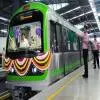- Paul Wallett, Regional Director, Trimble Solutions-Middle East and IndiaAmple availability of labour, coupled with limited access to software did not quite enable India to grab the opportunities that came along with Industry 3.0 However, with Industry 4.0 being here, where machines will be equipped with the ability to communicate, India is well poised to leverage it for significant gains, says Paul Wallett, Regional Director, Trimble Solutions-Middle East and India. In this interview, he shares more on this revolution and how Trimble is aligned with it, in a conversation with SHRIYAL SETHUMADHAVAN.How is Industry 4.0 an opportunity for stakeholders of the construction industry in India?For most part of my working life, I was in the 3.0 era when data and technology such as computers had just started to make their mark in the construction industry. As we know, we lived without computers for a number of years and then with the advent of Industry 3.0, computers got introduced into the drawing office. This was the early stage when people were shifting from the 2D environment into 3D automation and tools, and it was around the mid-80s when we started seeing the appearance of technology and evolution of the traditional processes to ones that had an application background. Today, we have machines that can scan materials, understand how the materials can be positioned on the beam and column, how to pick up the relevant piece of material and attach it in the right place to get perfect accuracy.Therefore, at the far end of 3.0, we see that the industrialised way of working has given way to a more automated and intelligent way of working. Industry 4.0 is an interesting era, and we are at the cusp of exciting times in the industry. We are looking at the adoption of AI and the use of IoT, we have lots of information collected on cloud that is of immense use, but utilising that data in the right way will be the key to how we drive our processes efficiently.How is Trimble aligned with Industry 4.0?In the case of BIM solutions, we are actually building structures utilising vast amount of information, and if we compare this to the 2D process, which is just lines, text and drawings and some dimensions, we are clearly moving to BIM components that have material data attached to all the information: Material type, the certification, design characteristics with visibility of whom it came from, and where it is going. Each integral piece of data built within the virtual 3D model has a lot of information that can be used in many different stages upto that particular material’s life-cycle, whether it is the material of a building or the assets within the building. Trimble has many different technology tools for design, analysis and concept modelling. For example, we have Tekla for the structures, we have MEP solutions as well as SketchUp, a widely used 3D design tool, all of which are immensely beneficial for the construction industry. We are utilising a vast array of different technologies towards problem-solving in construction, and aim to help the industry improve its productivity and thus, profitability. How is BIM along with Industry 4.0 (production domain), able to close the digital gap that still exists?Inherently, BIM is not a software, it’s a process. We have customers in India for the past 15-20 years who have been using our BIM solutions to provide services to the US and European markets, Far East countries, besides a few other countries globally. We have seen a marked increase in technology adoption in domestic projects, which tells us that the industry is moving towards a path to productivity and excellence of a higher order. During Industry 3.0, firms were focused heavily on the architecture-engineering part of the puzzle, and construction was traditionally tied to using drawings on the jobsite. This is where we are bringing about a change, and we are taking BIM to a level that we term as constructible.Is India geared up to catapult into the next revolution: Industry 4.0?We are seeing instances of how change is occurring and the changes forcing the industry towards more productive processes.For example, certain businesses that distribute parcels are now completely automated wherein robots scan the parcel and take it to the desired point. Historically, such a business would have had a lot of people shuffling parcels around and reading labels. Similarly, baggage handling systems at airports are fully automated in most cases. These are segments where the idea of labour-intensive approach has already been eliminated. When you have robots taking over repetitive processes, labour is freed up to take on even more critical tasks. Recently, there’s been an interesting partnership between Trimble, Hilti and Boston Dynamics to explore the integration of Trimble's and Hilti's construction management software solutions, GNSS technology and reality capture devices with Boston Dynamics' Spot Robot platform. The goal of this partnership is to utilise robots for routine tasks in hazardous environments to improve safety, efficiency, and data capture consistency as a part of our digital transformation vision.What are your expectations from the India market in 2020?In terms of growth, when we look at the global construction markets, we do see a few political and economic challenges in the near term. Macro issues are affecting regions around the world. Brexit, trade wars, lower consumer spends are a few factors that might have an impact on how the global construction market grows in the next few quarters. However, we have reasons to believe that India will outperform the global growth. Estimates show that from 2019 to 2023, the global construction market’s growth will be about 2.7 per cent, but the Indian market is projected to grow around 6.4 per cent. We believe that India should witness a sustained growth of over 6 per cent for the next few years. We have great confidence in the local Indian market for construction, especially with the amount of work going on in infrastructure that will fuel significant growth for the next several years, as well as key government initiatives such as Housing for All.To share your views on opportunities coming along Industry 4.0, write in at feedback@ConstructionWorld.in




















